One of the immediately noticeable features in any animal are arms, either long or short arms. Especially, If its arms and legs are disproportionate to each other we give more attention. Right? If not, then, Imagine a kangaroo, Jerboa, or Fiddle crab.
In this article, We shall look at Animals With Incredible Long & Short Arms that are all chosen from across the world.
You’ll be surprised while reading the purposes, function, and adaptation of their long and short arms. We also show you their beautiful pictures as well.
Table of Contents
Animals With Long Arms
Gibbons
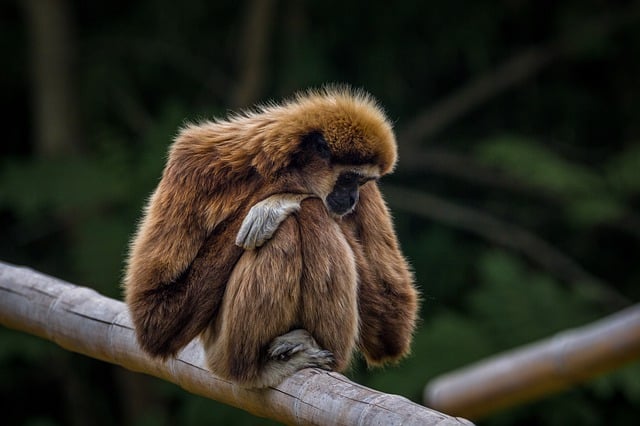
Gibbons, including about 18 species of them, are the lesser apes or small apes belonging to the family Hylobatidae and are found in eastern Bangladesh, southern China, Indonesia, islands of Sumatra, Borneo, and Java.
They have a really interesting locomotion called brachiation, which involves swinging through branches by using their long arms along with fingers used as hooks to hold the branches. Thus they can attain a speed of about 55 km/h (34 mph). Therefore, making themselves the fast tree-dwelling mammals.
These apes have longer arms that are about 1.5 times longer compared to their legs. For instance, a gibbon called as siamang gibbons known to have arm spans about 5 feet wide.
If its height to arms span proportion is compared to a human, then a 5 feet human would have a 10 feet arm span, that’s really a long arm. Right!
Orangutans
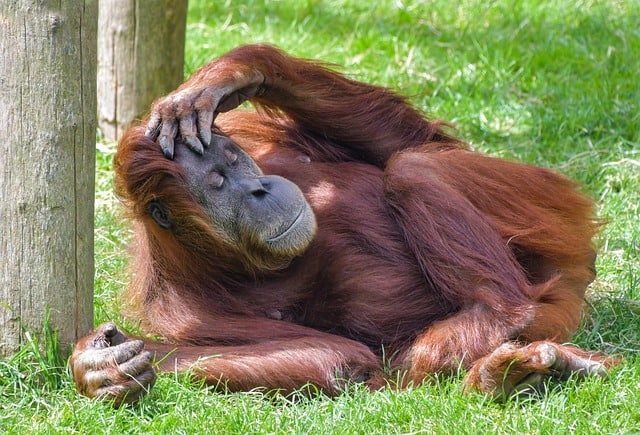
Orangutans, including Bornean orangutan, Sumatran orangutan, Tapanuli orangutan, means “man of the forest” are the great apes belonging to the family Hominidae, Subfamily Ponginae, and Genus Pongo. This arboreal is found in the Malaysian states of Sabah and Sarawak, Indonesia, and other places.
Upon comparison, with respect to the arms of humans and orangutans, orangutans have long arms that lead them to have an arm span of about 6.6 feet (2 m). Its arms are long with long fingers forming a suspensory hook for better grip.
Combination of hand and fingers including the opposable thumb enable them to use sophisticated tools and also to construct elaborate nests using foliage for resting.
Spider Monkeys
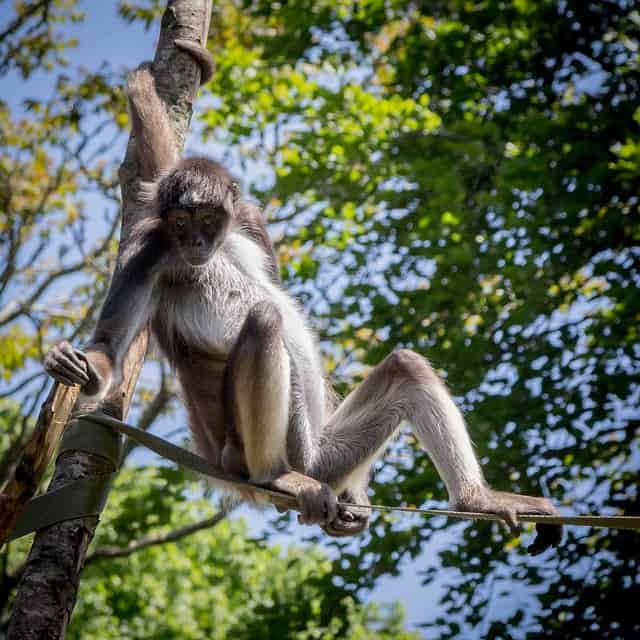
Spider monkey, including brown spider monkey, is a large monkey in the New World monkeys belonging to the family Atelidae, subfamily Atelinae, and genus Ateles. These are found in Central America, South America, southern Mexico, and Brazil.
Compared to other monkeys, These have Disproportionately long limbs both long arms and long legs, making them one of the largest New World monkeys. Its long arms, and hands with long hook fingers enable them better grip even though they lack opposable thumbs which is an adaptation to arboreal life.
Interestingly, While walking on the grounds they are less likely to use their arms for balancing like other monkeys. However, they have a long prehensile tail for supporting and balancing on both grounds and trees. It is set in genus Ateles, which refers to ‘imperfect’ as they lack opposable thumbs.
Siamang

The siamang, including Sumatran siamang and Malaysian siamang, is an arboreal ape in the Family Hylobatidae and Genus Symphalangus that are found in Indonesia, Malaysia, Thailand, and other places.
As they are the largest species among the gibbons (about 3.4 feet) they also have long arms that are longer than their own legs. Thus, It is twice the size of other gibbons. They have long arms such that the length of their arms is more than their own body length. Along with long arms, they also have long and broader hands through which they can swing about 10 feet of distance and walk on branches by outstretching their arms to bring balance.
While feeding in the tree they are capable of suspending themselves through one hand while the other hand is supported for feeding them.
Polar bear
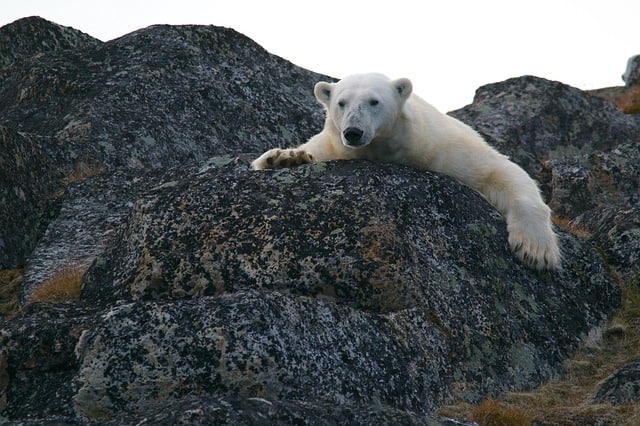
A polar bear, also known as a white bear, is a marine mammal that is primarily adapted for cold climates and is found in the north of the Arctic Circle, North Pole, Hudson Bay of Manitoba, Alaska, Canada, Russia, and Greenland.
These mammals have long arms with enormous paws about 12 inches (30 cm) equipped with claws. Through this combination of arms and claws they can run, climb, walk at a speed of about 5.5 kph, swim with a speed of about 40 kph (25 mph), also can penetrate the ice surface, or dig ice surface to come outside of water or to enter into it.
Its forelimbs or arms are used for many purposes such as walking, climbing and feeding. Interestingly, Its arms including its paws are helpful because they act as rudders while swimming, especially during swimming rapidly to catch prey such as seals and fishes.
Sloth
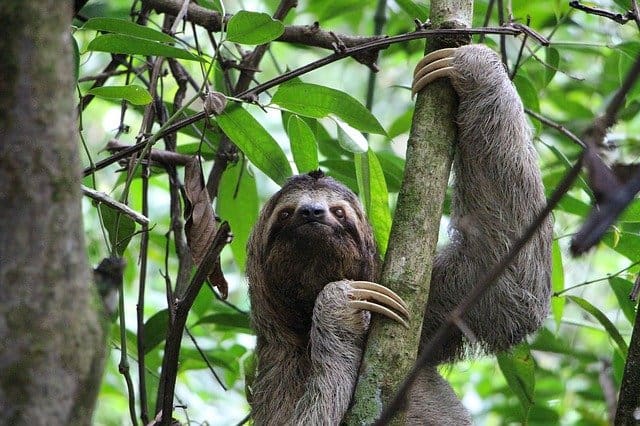
Sloths, including two-toed sloths and three-toed sloths, are arboreal mammals in the Order Pilosa and are found in Central America and northern South America, including parts of Brazil, Peru, and other places.
One noticeable feature in them is their long arms with long and hook-shaped claws that they use for hanging in the tree branches. Interestingly, while doing so if they die then they will remain in that hanging position on tree branches. For sloths, hanging through their arms and claws requires no effort.
However, Its claws interfere while walking on the ground as they are not adapted to do so which can sometimes make them susceptible to predators because of their slow movement.
Fortunately, they are good at swimming as they can attain a swimming speed of about 44 feet per minute. For swimming, they use their long arms like a paddle, thus they can cross rivers and even islands.
When we compare the arms of three-toed sloths with two-toed sloths, the arms of the three-toed sloths are 50 percent longer than their legs.
Brittle Star

Brittle stars, also known as serpent stars, or ophiuroids, are echinoderms found in brackish polar areas, marine habitats of the Indo-Pacific region, and other places.
We can immediately notice its long arms as it took more proportionate of its body. It has five long arms that are long, flexible, slender, whip-like arms, that all make them look like a snake that’s why they are named serpent stars.
Surprisingly, Brittle stars have regeneration powers, which means they are capable of growing back the lost part of its body that usually happens to its arm. They take advantage of this regeneration ability with their predators, when being attacked by predators, brittle stars will lose one of their arms to confuse the predators while escaping and grow back their lost part.
Its arms are used for locomotion, movement, sensing odor, detecting light at the tip of each arm. Interestingly, They are known to hold objects even after death because of its arms are coiled to an object while they are living.
Fiddler Crab
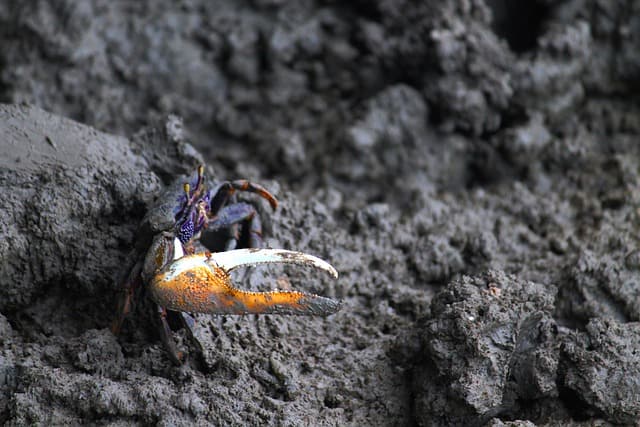
The fiddler crab, also known as a calling crab, is a marine crab belonging to the family Ocypodidae and is found in West Africa, Western Atlantic, the Eastern Pacific, Indo-Pacific, and other places.
As you might notice its disproportionate claws (some treat claws as arms as well) are longer and larger than its opposite claws and are also larger in proportion to their body when compared with other crabs.
Its large claws (arms) play an important role in attracting females for mating and also to chase away other males that are competing for food, and mating. Upon approaching female crabs, these males with larger arms (claws) wave to her that action looks like they are drumming, and playing violin.
In male crabs, larger the claw the healthier crabs will be, and are known to attract more females.
Humpback Whale

The humpback whale is a marine animal, also a species of baleen whale that belongs to the Family Balaenopteridae and Genus Megaptera. These are found in the north Pacific, South-East Alaska, British Columbia, Hawaii, the Gulf of California, Mexico and Costa Rica.
If we could represent the pectoral fins as arms which actually more or less serves the same purpose of arms especially to whales for swimming. Thus its pectoral fins, arms or sometimes treated even as flippers, is so massive about 16.4 ft (5 m) long that makes them the longest fins in the entire world and is also one third of its total body length.
Its long fins (arms) are very strong and are necessary as they are required to propel the 30 ton weighing animal through the water, thus they can attain a speed of about 10 mph (16 km/h), that’s impressive.
Bat

Bats are the flying mammals in the order Chiroptera and when it comes to location it is best to tell its habitats than the countries because they are found almost in every country, thus its habitats includes deserts, woodlands, caves, bridges, cities and others.
For a biologist it is amazing, when he hears a mammal capable of true and sustained flight like the birds. Yes, It’s amazing because mammals are heavy due to their heavy bones that are tough to launch flight or to adapt for flying when compared to those birds with hollow bones.
However, some mammals and non-mammals such as sugar gliders, flying frogs(tree frogs, parachute frogs) can fly or glide through air but could not launch a true flight like a bird.
Bats have forelimbs that are adapted for true flight because they have long wings that are actually the modified arms with five elongated digits that all radiate after the wrist. While the thin skin membrane called patagium spread-out along its long fingers. This combination of arms, wrist fingers and patagium gives them flying ability.
The largest species of bat can have a wingspan (or arm span) about 5 ft 7 inch (1.7 m)- that’s really huge. Right!
Octopus
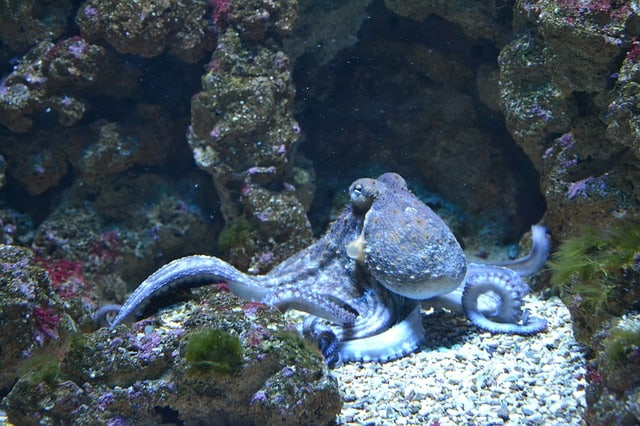
Octopus is a marine animal belonging to molluscs that are set in Order Octopoda and are found in almost every ocean across the world.
Weird octopus, Yes, because they have three hearts and blue blood but surprisingly eight arms that they can use as even legs according to their need such as locomotion, swimming, eating, and what not- i mean still list goes.
Both male and female octopus have eight long arms but no tentacles. However, Male octopus has a specialised arm that is meant for sperm delivery, and is called hectocotylus. This feature can help them to distinguish between the male and female octopus.
Its each arm is about 4.3 feet in length in which they have their own small brain for controlling movements. Thus, a large species of octopus can have an arm span of about 30 feet (9 metres) in length.
Squids

Squid is carnivorous mollusc in the superorder Decapodiformes and order Teuthoidea that are found in oceans across the world.
Surprisingly, Squid are the sea creatures with eight arms and two tentacles. Through its stronger and longer arms they capture prey and hold them with better grip due to the presence of hooks and suckers on their surface.
Arms or tentacles are used differently or sometimes refer to the same depending on the species of squids. For example, some say squids have 10 arms in which two are arms while the other eight are tentacles, colossal squids have eight arms and the other two are referred to as tentacles.
A squid species named as Bigfin squid (Magnapinna) is found to have long arms and tentacles that can measure about 7 m (22 feet) in length, now you can imagine-that’s really huge.
Animals With Short Arms:
Long Eared Jerboa

The long-eared jerboa is a nocturnal mammal set in the family Dipodidae, which means jumping rodents, and is found in the Palearctic ecozone, Gobi, Sahara deserts, Mongolia, and other places.
They have relatively shorter arms or forelimbs than their hindlimbs or feet. Its short arms are helpful in eating, holding objects, foods, grooming, and burrowing as they live in burrows. Its arms are not easily seen due to their hindlimbs that are so long, almost comparable to those of a kangaroo in proportion to their legs to the body.
Surprisingly, Jerboas have short arms that are thin and small in size that are kept close to their chest.
Kangaroo
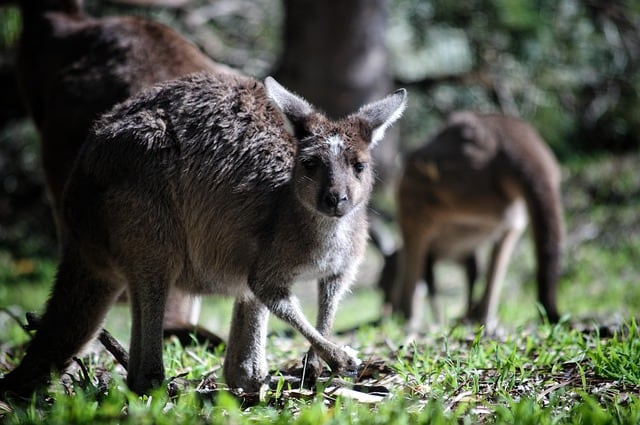
A Kangaroo is a large animal among the marsupials belonging to the Family Macropodidae and are found in Australia. Females of these species have pouches that contain mammary glands and young.
When compared to its forelimbs with hindlimbs, Its forelimbs are shorter than its hindlimbs. Thus, Its forelimbs are short and have five fingers each equipped with sharp claws, this combination is used for grabbing, fighting, grooming, feeding, walking slowly if they aren’t hopping, and can be capable of hurting or injuring intruders if threatened.
Some kangaroos, wild kangaroos, use their left arms (paws, hands) while doing their common tasks such as grooming and feeding. That seems amazing for humans as we are right-handed.
Wallabies

The wallaby, including red-necked wallaby, is a middle-sized macropod and is also a herbivorous marsupial that is found in Australia, New Guinea, New Zealand, Hawaii, the United Kingdom, Tasmania, and nearby islands.
When compared, these animals look like kangaroos but are not so, have short arms compared to their long and strong hindlimbs, and each arm is equipped with five digits and claws in each digit.
This combination of arms with paws and claws is used for many purposes such as pulling down branches, fighting, grooming, cleaning its pouch, and eating as well.
Spring Hare
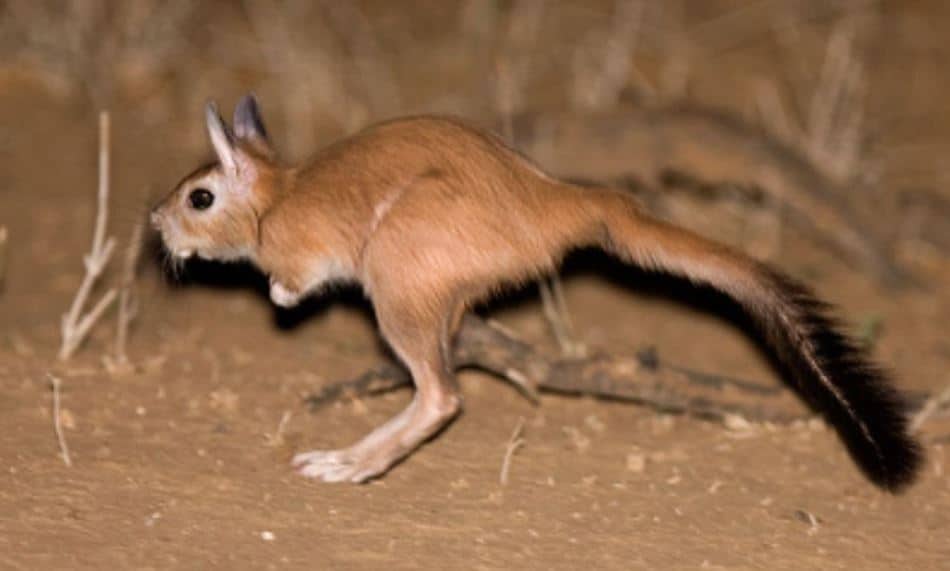
The Springhare is a large-sized nocturnal rodent in the Order Rodentia, Family Pedetidae, and Genus Pedetes, that do not actually belong to the hare and are found in the dry savannas of Kenya, Tanzania, Southwestern Africa.
Even If it does look like a mini kangaroo or T-rex it is not actually related to them and nor belongs to hares. These are unusual rodents as they look like kangaroos because of their long hindlimbs and shorter forelimbs. It has short forearms (forelimbs) than its hindlimbs that seem to be the arms of a T-rex and is used for digging, eating, burrowing, grooming, and climbing as well.
Its combination of long hindlimbs, short forelimbs, and large tail make them look like a mini version of a ‘T-Rex’
Tyrannosaurus rex
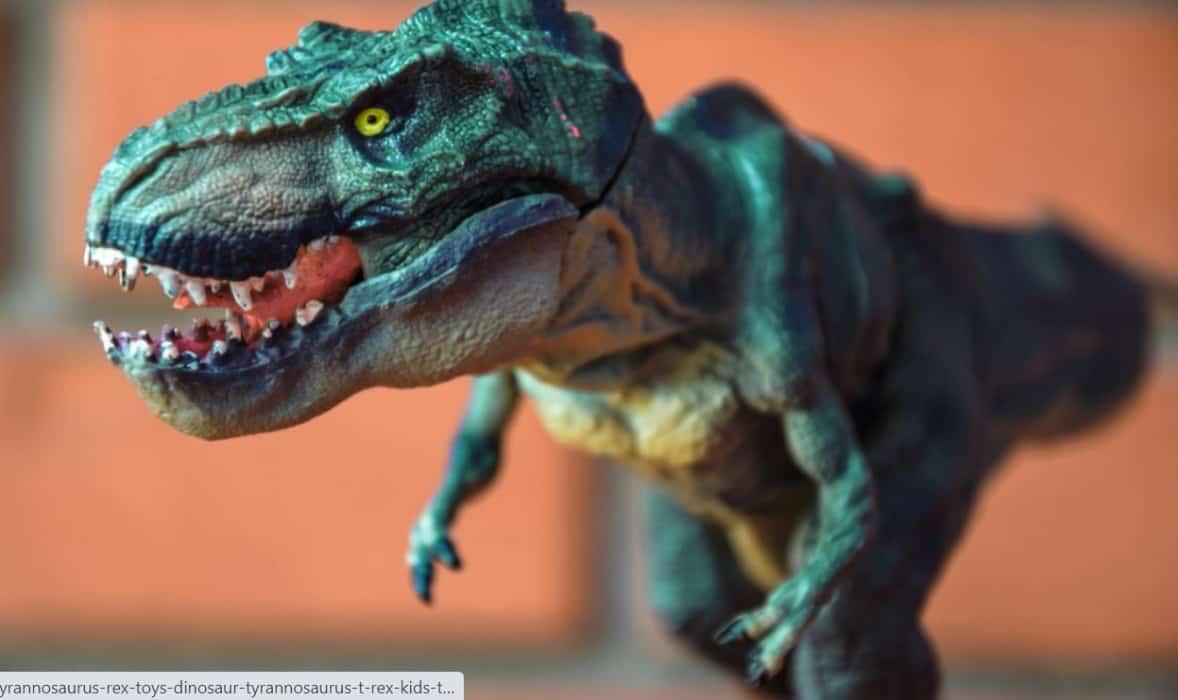
The Tyrannosaurus rex, also known as T. rex, where Rex literally means ‘king’ in Latin that is bipedal carnivorous. These extinct animals were found to live in North America, Laramidia, and other places millions of years ago.
They have relatively shorter forelimbs (forearms) than their hindlimbs that are often held towards their chest and are used for eating, holding the prey firmly that is supported because of their two clawed digits in each arm. Its forelimb or arm was very short because the upper arm bone called the humerus was short.
Its arm is short because of the presence of smaller bones in its upper and lower arm.
Read More : Animals With Multiple Eyes !
Do all monkeys have long arms?
No, but almost all monkeys have long arms and are necessary for them because they are adapted for arboreal life. These long arms are used for many purposes. Some of the main reasons and functions are to climb trees, to hang from branches, to move from branch to branch, to catch the branches that are away from them, and to grab the foliage, fruits, food, and their babies.
How are long arms useful to Gibbons?
Gibbons have longer arms than any primates and it can be useful in many ways that can be to swing through the trees by using their long arms, thus they can cover 10m or more distances in a swing, can be used to attain a speed of about 34 miles per hour they use their long arms, in order balance while walking along the branches as they outstretch their hands, For swinging with less effort, they use their long arms like a long hook so that they can swing more efficiently.
Which animal has longer arms than legs?
Humpback Whales have the longer pectoral fins (also referred to as flippers, or arms) about 16.4 ft (5 m) long, making them animals with the longest fins in the entire world. It measures about one-third of its total body length.
Among the primates, Gibbons has the longest arms when compared to other monkeys because its arms are long in proportion to its body.
Sources:
https://www.audubon.org/news/why-do-kangaroos-have-short-arms
